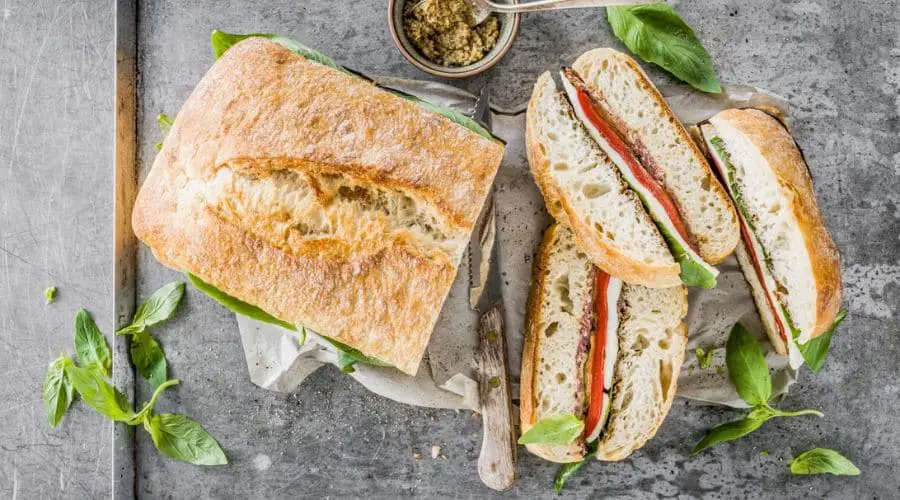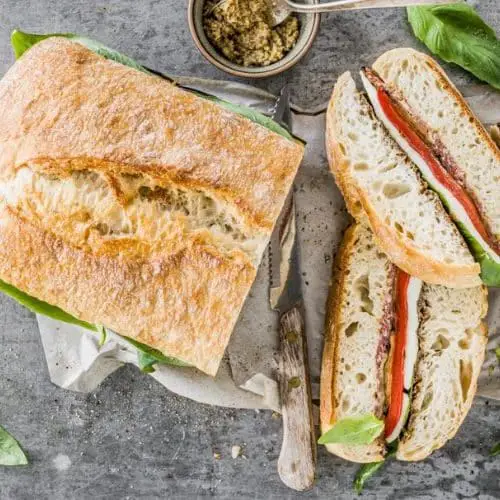All products are selected by our editorial team for quality. If you buy through our links, we may earn a small commission at no extra cost to you.
Ciabatta is an Italian bread that has gained international popularity for its rustic appearance and airy, slightly chewy texture.
It was first created in 1982 by baker Arnaldo Cavallari in Italy as a response to the growing demand for French baguettes.
The name “ciabatta” translates to “slipper,” which is a reference to the bread’s flat, somewhat uneven shape, resembling a slipper.
What makes Ciabatta unique is its crispy crust and soft, open crumb structure.
This distinctive texture is achieved through the high hydration of the dough and the use of a starter called a “poolish,” which adds flavor and lightness.
Ciabatta is incredibly versatile—it can be used for sandwiches, served with olive oil and balsamic vinegar, or simply enjoyed with a bit of cheese.
Whether you’re a seasoned baker or new to bread-making, Ciabatta is a rewarding bread to bake at home, and its delightful texture and flavor make it a favorite among many.

What You Need to Know About Ciabatta Ingredients
Ciabatta bread relies on a few simple ingredients, but the key to getting that perfect texture lies in how you use them.
To start, you’ll need high-quality flour.
Bread flour is the best choice because it has a higher protein content, which helps develop the gluten structure and gives the bread its chewy texture.
All-purpose flour can also work, but you may notice a slight difference in texture.
Next, you’ll need water, which is essential for creating the sticky, high-hydration dough that gives Ciabatta its signature open crumb.
The water should be room temperature to help activate the yeast without killing it.
Too much or too little water will affect the texture, so it’s important to get the ratio just right.
Salt is added for flavor, but it also strengthens the gluten structure and controls yeast activity.
It’s important not to add too much, as excess salt can inhibit the yeast’s ability to rise.
The most crucial ingredient in Ciabatta is the yeast.
Typically, active dry yeast or instant yeast is used to make the dough rise.
Using a starter, or poolish, is common in traditional recipes, as it imparts additional flavor and lightness to the bread.
Poolish is a mixture of equal parts flour and water with a small amount of yeast, fermented overnight.
Some recipes may call for additional olive oil, which can enhance the bread’s flavor and texture, but it’s not essential to the classic Ciabatta recipe.
It’s often used in variations where a slightly richer crumb is desired.
Finally, you can experiment with optional ingredients like herbs, olives, or roasted garlic to add unique flavor to your Ciabatta.
But the classic version keeps things simple, letting the natural flavors of the flour, water, and yeast shine through.
Step-by-Step Guide to Making Ciabatta

Preparing the Poolish (Starter)
The first step in making Ciabatta is to prepare the poolish, which is a fermented starter made from flour, water, and a small amount of yeast.
To create the poolish, mix equal parts of flour and water. For example, combine 100 grams of flour with 100 grams of water.
Add a pinch of yeast—about 0.1 grams—into the mixture and stir well to combine.
Cover the bowl with a damp cloth and let the poolish ferment at room temperature for 12 to 16 hours, or overnight.
The poolish should become bubbly and slightly tangy, which is an indication that it’s ready to use.
Mixing the Dough
Once your poolish is ready, it’s time to mix the dough.
In a large bowl, combine the poolish with additional flour, water, salt, and yeast.
Add around 400 grams of flour, 250 grams of water, and 10 grams of salt to the poolish.
Stir the mixture until a sticky dough forms. The dough should be quite wet and loose, which is characteristic of Ciabatta.
Use a wooden spoon or your hands to mix until the ingredients are well incorporated.
The First Rise (Bulk Fermentation)
Now that your dough is mixed, it’s time to let it rise.
Transfer the dough to a lightly oiled bowl and cover it with plastic wrap or a damp towel.
Let the dough rise for about 1 to 1.5 hours at room temperature.
During this time, the dough should double in size and become airy and bubbly.
For the best results, you can also perform a series of “stretch and folds” every 30 minutes during the first rise to develop the dough’s structure.
Shaping the Ciabatta
After the dough has risen, it’s time to shape it into the iconic Ciabatta form.
Lightly flour your work surface to prevent sticking, then gently turn the dough out onto the counter.
Carefully stretch and fold the dough into a rectangle shape, trying not to deflate the air bubbles that have formed inside.
Ciabatta is not shaped like a traditional round loaf, so it should be a flatter, irregular shape, which gives it its rustic look.
Second Rise (Proofing)
Once shaped, transfer the dough to a well-floured kitchen towel or a baking sheet lined with parchment paper.
Cover the dough with a towel and let it proof for another 45 minutes to 1 hour.
The dough should puff up slightly, and you may notice it becoming more airy.
This second rise is crucial for creating the signature open crumb of Ciabatta.
Baking Ciabatta to Perfection
Oven Temperature for a Crisp Crust
Preheat your oven to 450°F (230°C) at least 30 minutes before baking.
The high temperature will help create a crisp, golden crust that is one of Ciabatta’s defining features.
If possible, place a baking stone or steel in the oven to ensure even heat distribution, which promotes a better rise and crust.
Achieving the Golden-Brown Color
Before placing the dough in the oven, add steam to the baking process.
This can be done by placing a pan of water on the bottom rack of the oven or spritzing the dough with water.
The steam will help create a beautiful, shiny crust.
Bake the Ciabatta for about 20-25 minutes, or until it turns a deep golden brown.
The crust should be firm and crisp to the touch, while the bread itself should sound hollow when tapped on the bottom.
Checking Doneness
To check if your Ciabatta is fully baked, tap the bottom of the loaf. If it sounds hollow, the bread is done.
If not, return it to the oven for a few more minutes and check again.
Allow the Ciabatta to cool on a wire rack for at least 30 minutes before slicing to preserve its texture and flavor.
Enjoy your homemade Ciabatta fresh or use it for delicious sandwiches or dips.
Storing and Serving Ciabatta
After baking your Ciabatta, it’s important to store it properly to maintain its freshness.
To keep your Ciabatta at its best, allow it to cool completely before storing.
Once cooled, wrap the bread loosely in a clean kitchen towel or paper bag. This will help maintain the crust’s crispiness while keeping the interior soft.
Avoid wrapping it tightly in plastic, as this can cause the bread to become soggy due to trapped moisture.
Ciabatta is best enjoyed within the first few days of baking. If you’re not planning to eat it right away, you can freeze it to preserve its freshness.
To freeze Ciabatta, wrap it tightly in plastic wrap or aluminum foil, then place it in a freezer bag. When you’re ready to eat it, simply thaw it at room temperature and refresh the crust in a preheated oven for a few minutes.
Ciabatta is incredibly versatile. You can serve it sliced for sandwiches, toasted with butter or olive oil, or paired with balsamic vinegar and olive oil for dipping.
It also pairs wonderfully with soups, salads, and cheeses, making it an excellent accompaniment to many meals.
Conclusion
Baking Ciabatta bread at home may seem intimidating at first, but with patience and the right techniques, anyone can achieve a beautifully rustic loaf with a perfect combination of a crisp crust and airy, open crumb.
By following the detailed steps, from making the poolish to baking the bread to perfection, you’ll be able to enjoy the rich, satisfying flavor of homemade Ciabatta.
Experiment with the recipe, try different variations, and most importantly, savor the process of creating this delicious, versatile bread from scratch. Whether for a special meal or an everyday treat, Ciabatta is sure to impress.
Frequently Asked Questions
1. Can I make Ciabatta without a poolish?
Yes, while using a poolish is traditional and helps enhance the flavor, you can still make Ciabatta without it.
You can substitute the poolish with a bit more yeast or a longer fermentation time for the dough.
2. Why is my Ciabatta dough so sticky?
Ciabatta dough is naturally very sticky due to its high hydration.
This is what helps create its open crumb structure.
You can wet your hands or use a dough scraper to handle it without sticking.
3. Can I make Ciabatta with whole wheat flour?
Yes, you can substitute part of the bread flour with whole wheat flour, but keep in mind that it may result in a denser loaf with a slightly different flavor.
4. How do I achieve the perfect Ciabatta crust?
To get a crisp crust, ensure the oven is preheated to a high temperature (around 450°F or 230°C) and add steam during the baking process.
You can do this by placing a pan of water in the oven or spraying the dough with water before baking.
5. Can I make Ciabatta without a stand mixer?
Yes, you can mix and knead Ciabatta dough by hand.
Since the dough is quite wet, it will require some patience, but the result will be just as good.
You can also use the stretch-and-fold method during the rise to help develop the gluten.

Ciabatta
Equipment
- 1 large mixing bowl
- 1 Dough scraper or spatula
- 1 measuring cup
- 1 Digital kitchen scale (optional for accuracy)
- 1 Baking stone or sheet
- 1 Parchment paper
- 1 Tea towel or plastic wrap
- 1 Wire rack (for cooling)
Ingredients
For the Poolish (Starter):
- 100 grams Bread flour
- 100 grams Water
- 0.1 grams Active dry yeast a pinch
For the Dough:
- 400 grams Bread flour
- 250 grams Water
- 10 grams Salt
- 2 grams Active dry yeast or 1/2 teaspoon
Instructions
Prepare the Poolish:
- In a small bowl, mix 100 grams of bread flour with 100 grams of water. Add a pinch (0.1 grams) of active dry yeast and stir until combined. Cover the bowl with a damp cloth and let it sit at room temperature for 12–16 hours (or overnight) until bubbly and slightly tangy.
Mix the Dough:
- In a large mixing bowl, combine the poolish with 400 grams of bread flour, 250 grams of water, 10 grams of salt, and 2 grams of yeast. Stir until the dough begins to come together.
Knead the Dough:
- Turn the dough out onto a lightly floured surface and knead for about 8-10 minutes. The dough will be sticky, but continue kneading until it becomes smooth and elastic. You can also use the stretch-and-fold method every 30 minutes during the first rise.
First Rise:
- Place the dough in a lightly oiled bowl and cover it with plastic wrap or a damp towel. Let the dough rise at room temperature for 1 to 1.5 hours, or until it has doubled in size.
Shape the Dough:
- Gently turn the dough out onto a floured surface. Stretch and fold the dough into a rough rectangular shape. Try to maintain the air bubbles inside.
Second Rise (Proofing):
- Transfer the dough to a parchment-lined baking sheet or a floured kitchen towel. Cover and let it rise for 45 minutes to 1 hour, or until slightly puffed.
Preheat the Oven:
- Preheat the oven to 450°F (230°C) for at least 30 minutes, placing a baking stone or sheet inside if you have one.
Bake the Ciabatta:
- Place the dough in the preheated oven and bake for 25–30 minutes. The bread should be golden brown with a crisp crust. To check doneness, tap the bottom of the loaf; it should sound hollow.
Cool:
- Allow the Ciabatta to cool on a wire rack for at least 30 minutes before slicing.
Notes
- Hydration: Ciabatta is a high-hydration bread, meaning the dough will be sticky and wet. This is normal and contributes to its open crumb. Be sure not to add too much extra flour during mixing or shaping.
- Poolish: If you don’t have time for the overnight fermentation, you can skip the poolish and directly mix the ingredients. However, the flavor will not be as complex.
- Storage: Ciabatta is best eaten within the first few days. To store, wrap it in a clean kitchen towel or paper bag to preserve the crust. You can also freeze Ciabatta for up to a month.

